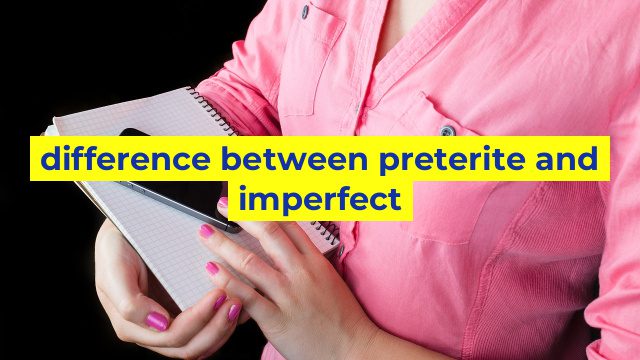Understanding the Difference between Preterite and Imperfect Tenses
When it comes to learning Spanish verbs, two of the most commonly used tenses are the preterite and imperfect. These two tenses play a crucial role in expressing the past tense of verbs, but they have different uses and nuances. Understanding the difference between them can help you communicate more effectively in Spanish.
The Preterite Tense
The preterite tense is used to describe completed actions in the past. It is used for events that happened at a specific time, with a clear beginning and end. For example, “I ate breakfast at 8 am this morning” would use the preterite tense.
The preterite tense is also used for series of consecutive events that occurred in the past. For example, “I woke up, got dressed and went to work” would use the preterite tense.
When conjugating regular verbs in the preterite tense, you need to add the following endings:
-ar verbs: -é, -aste, -ó, -amos, -asteis, -aron
-er/ir verbs: -í, -iste, -ió, -imos, -isteis, -ieron
The Imperfect Tense
The imperfect tense, on the other hand, is used to describe actions that were ongoing, habitual or simultaneous in the past. It is also used to describe background information or set the context of a story.
For example, “When I was young, I used to play basketball every Saturday” or “It was a beautiful day and the sun was shining” would use the imperfect tense.
When conjugating regular verbs in the imperfect tense, you need to add the following endings:
-ar verbs: -aba, -abas, -aba, -ábamos, -abais, -aban
-er/ir verbs: -ía, -ías, -ía, -íamos, -íais, -ían
Using Both Tenses Together
In some cases, you might need to use both the preterite and imperfect tenses together. This can happen when describing a past event and the background information that happened before it.
For example, “When I was walking to the store yesterday, I saw my friend and we talked for a bit” would use the imperfect tense for the background information and the preterite tense for the specific event.
In conclusion, understanding the difference between preterite and imperfect tenses is essential to communicate effectively in Spanish. While the preterite tense is used for completed actions in the past, the imperfect tense is used for habitual actions, background information or actions that were ongoing in the past. By practicing these tenses, you can improve your Spanish communication skills and increase your fluency.
Table difference between preterite and imperfect
| Preterite | Imperfect |
|---|---|
| Used to describe completed actions or events that happened at a specific time in the past. | Used to describe ongoing or habitual actions or events in the past, without a specific beginning or end. |
| Uses specific time markers, such as “ayer” (yesterday), “anoche” (last night), or “la semana pasada” (last week). | Uses more general time markers, such as “siempre” (always), “cada día” (every day), or “a menudo” (often). |
| Focuses on the beginning or end of an action or event. | Focuses on the ongoing state of an action or event. |
| Can be used to express a series of completed actions or events. | Can be used to provide context or background information for a story or narrative. |
| Examples: “Comí una pizza ayer” (I ate a pizza yesterday). | Examples: “Solía correr por el parque cada mañana” (I used to run in the park every morning). |


